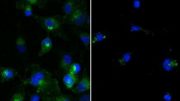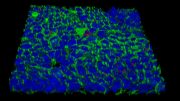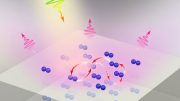
Star formation in the outer spiral regions of the galaxy NGC 4625 is seen in ultraviolet light (blue); these arms are nearly invisible in optical light, but have hot, newborn stars that radiate in the UV. The atomic gas is traced in the radio (purple); optical starlight is red. NASA/JPL-Caltech/Carnegie Observatories/WSRT
A newly published study from the Harvard-Smithsonian Center for Astrophysics finds that the star formation processes in the outer spiral regions of the galaxy NGC 4625 generally resemble the processes at work in more normal, denser regions where molecular gas abounds.
Star formation environments can be roughly grouped into three types, categorized by the density of their gas (or more precisely, the projected “surface” density of the gas, which is easier to determine than the conventional volume density). In moderately high-density regions, where the gas is primarily molecular in form rather than atomic, there is a strong correlation between the amount of star formation taking place and the density. This result is the basis for concluding that stars form from molecular material. In very high-density regions like those found in merging and starbursting galaxies, the star-formation rates compared to the total mass of available material are even larger. In low-density regions there is little known about correlations between the total gas and star-formation activity.
Low-density regions, however, are important: they can cover very large spatial extents in the outer domains of galaxies, going well beyond the sizes defined by starlight in the optical. Recently, sensitive searches for molecular gas in these outer regions have been able to map that component, while ultraviolet surveys have spotted UV emission from up to four times farther out in galaxies than the nominal, optical radius. Since the UV is produced by hot young stars, the presumption is that there are new stars forming there. Does star formation in these outer regions correlate with the gas density in the same way as higher density regions, or might perhaps the star formation process proceed differently?
CfA astronomer Linda Watson led a team of five colleagues to address these questions. They analyzed published observations of carbon monoxide gas (a bright tracer of molecular material) in fifteen outer regions of the galaxy NGC 4625 where UV was spotted but which are faint in the optical, and derived the relationship between star formation and gas density. They found that in general the activity is consistent with the same physical processes at work in the brighter, inner regions of the galaxies, a finding that is somewhat reassuring for theorists. But they also spotted a few outer locations where something different was happening: much higher rates of stars were being formed. Molecular gas is a crude tracer for age (because it takes time to convert atomic material into molecular), and most of the regions in this study are estimated to be between about one-to-seven million years old. The scientists raise the possibility that evolutionary effects between these regions could be at work, and urge deeper carbon monoxide observations to facilitate a broader analysis.
Reference: “Testing the molecular-hydrogen Kennicutt–Schmidt law in the low-density environments of extended ultraviolet disc galaxies” by Linda C. Watson, Paul Martini, Ute Lisenfeld, Torsten Boker, and Eva Schinnerer, 18 November 2015, MNRAS.
DOI: 10.1093/mnras/stv2412









Be the first to comment on "Astronomers Observe Star Formation in the Outskirts of Galaxies"